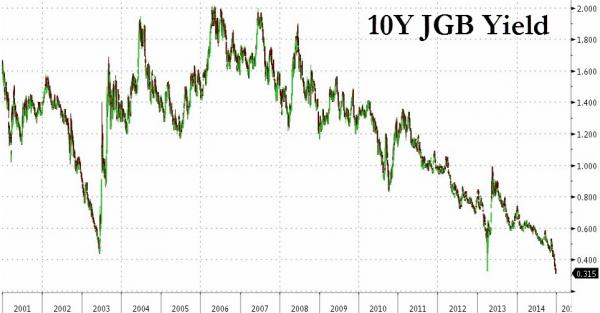While the rest of the world was preparing to celebrate Christmas, China was busy easing its economy into growth, and its stock market into low earth orbit, by lowering non-bank deposit reserve rates to zero as reported previously, while Japan was enjoying the consequences of the BOJ monetizing 100% of all gross JGB issuance, when overnight the Japanese Ministry of Finance not only sold $22 billion in 2 Year paper at a negative yield of -0.003%: the first time ever a government note (not bill) has sold at a negative yield, but the Japanese 10 Year yield dropped to 0.31%, declining below the previously all time low hit on April 2013 when the BOJ first announced its unprecedented QE program.

While negative auction yields have moved steadily along the Japanese yield curve, with three-month and one-year bills already sold at sub-zero yields earlier this year, the relentless surge in bond prices, and tumble in yields, merely confirms what we said recently: the global shortage of high quality collateral (set to get 20% worse in 2015) will wreak havoc with the central-planners’ intention to boost yields in “confirmation” that a reflationary recovery has taken place.
Case in point: as Reuters reminds us, in Europe, the two-year German bund yield has spent most of its time since August beneath zero, while in the Swiss government debt market even the five-year yield has gone negative.
At this point it is probably worth updating the chart showing how many billions in European Treasury debttrade at negative yield. Ironically, the bond market is now so broken that Japanese yields, already at record lows, are actually higher than matching maturities in many European countries.

So what is causing this market distortion? Why the BOJ of course. Recall that as we showed previously, following its latest QE expansion the BOJ is set to monetize all gross issuance in 2015.

But it is not just gross issuance: the BOJ is also buying up existing bonds from the private market, i.e., the infamous POMO pathway, which means that all the BOJ is doing is enabling the purchases of other securities from those it buys bonds from (at a markup since the BOJ is completely cost-insensitive).

